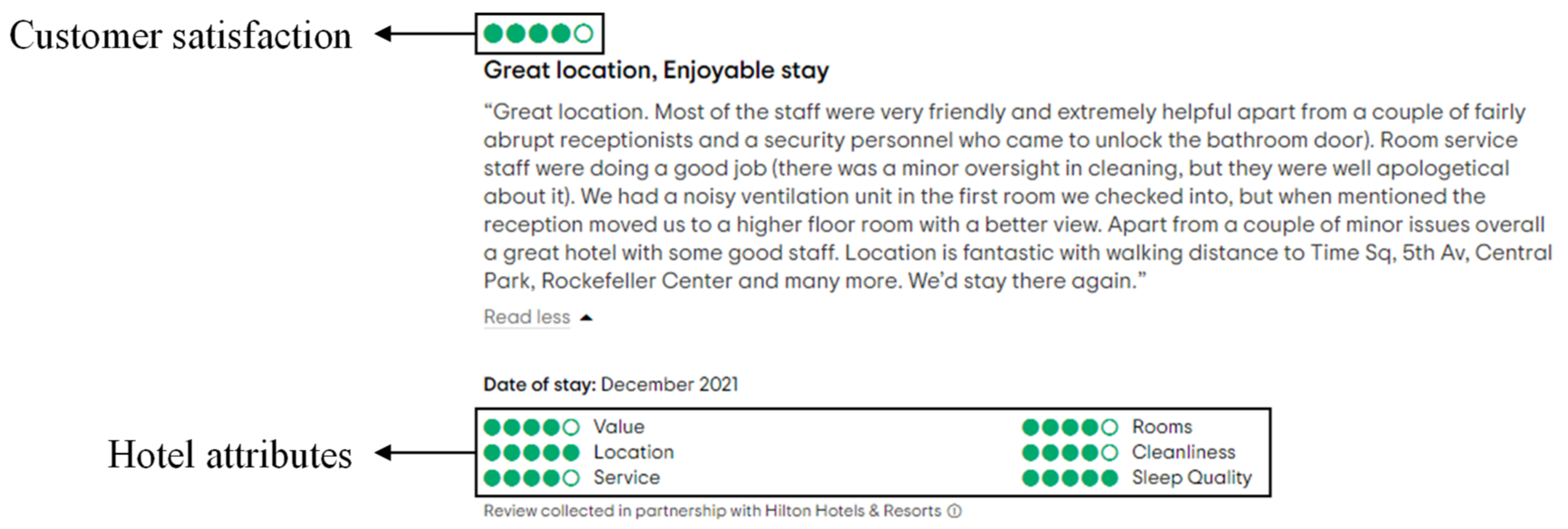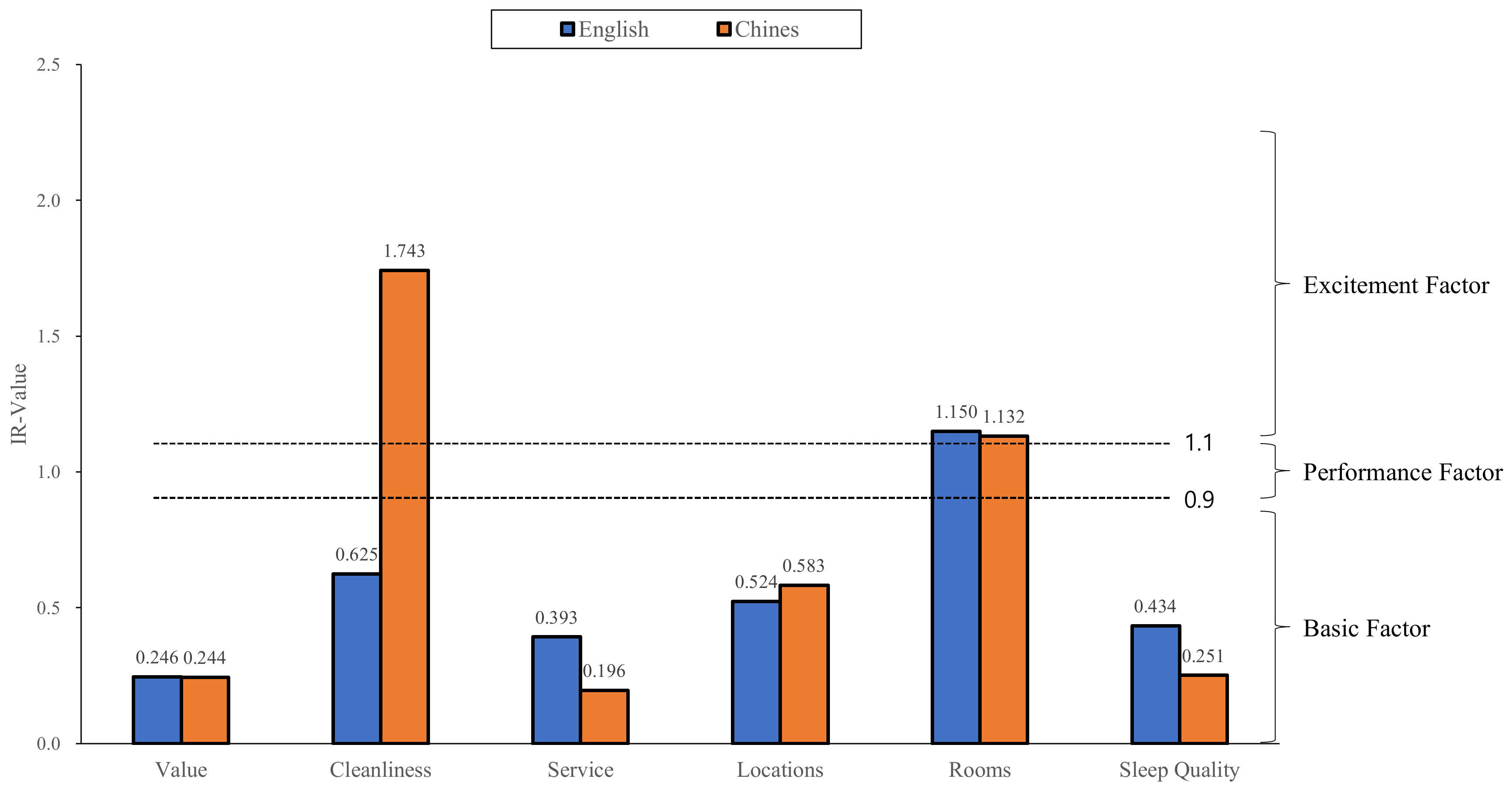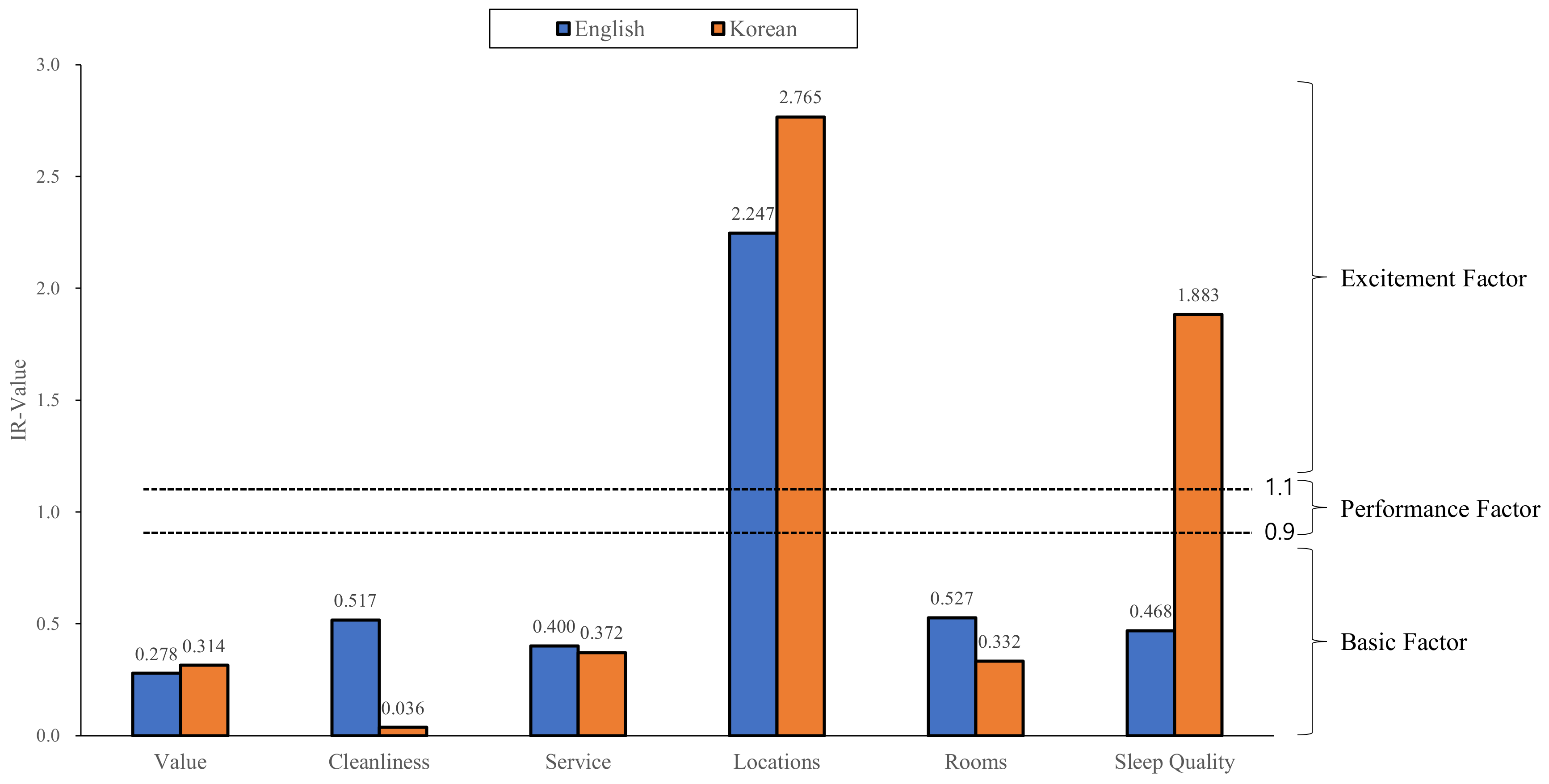Hotel Service Analysis by Penalty-Reward Contrast Technique for Online Review Data
Abstract
:1. Introduction
2. Research Background
2.1. Three-Factor Theory of Customer Satisfaction
- Basic factor: A factor that causes dissatisfaction if not satisfied yet does not lead to satisfaction if satisfied or exceeded, and has an asymmetric effect on customer satisfaction. Negative performance on these attributes has a greater impact on overall satisfaction than positive performance.
- Excitement factor: A factor that increases customer satisfaction if satisfied, but does not cause dissatisfaction if not satisfied, and has an asymmetric effect on customer satisfaction like a basic factor.
- Performance factor: High performance leads to satisfaction while low performance leads to dissatisfaction, which has a symmetrical effect on customer satisfaction.
2.2. Penalty-Reward Contrast Analysis
2.2.1. Dummy Variable Conversion
2.2.2. Quality Attributes Classification
3. Method
3.1. Data Collection
3.2. Apply Penalty-Reward Contrast Analysis
3.2.1. Dummy Variable Conversion
3.2.2. Regression Analysis
3.2.3. Attribute Classification
4. Results
4.1. Descriptive Analysis
4.2. Geographical Differences in Destinations for The Asymmetric Effects of Hotel Attributes
4.3. Cultural Differences in the Asymmetric Effects of Hotel Attributes
5. Conclusions
Author Contributions
Funding
Institutional Review Board Statement
Informed Consent Statement
Data Availability Statement
Acknowledgments
Conflicts of Interest
References
- Kandampully, J.; Suhartanto, D. The role of customer satisfaction and image in gaining customer loyalty in the hotel industry. J. Hosp. Leis. Mark. 2003, 10, 3–25. [Google Scholar] [CrossRef]
- Dominici, G.; Guzzo, R. Customer satisfaction in the hotel industry: A case study from Sicily. Int. J. Mark. Stud. 2012, 2, 3–12. [Google Scholar] [CrossRef] [Green Version]
- Jannach, D.; Zanker, M.; Fuchs, M. Leveraging multi-criteria customer feedback for satisfaction analysis and improved recommendations. Inf. Technol. Tour. 2014, 14, 119–149. [Google Scholar] [CrossRef]
- Li, H.; Ye, Q.; Law, R. Determinants of customer satisfaction in the hotel industry: An application of online review analysis. Asia Pac. J. Tour. Res. 2013, 18, 784–802. [Google Scholar] [CrossRef]
- Abbasi, A.S.; Khalid, W.; Azam, M.; Riaz, A. Determinants of customer satisfaction in hotel industry of Pakistan. Eur. J. Sci. Res. 2010, 48, 97–105. [Google Scholar]
- Bulchand-Gidumal, J.; Melián-González, S.; Lopez-Valcarcel, B.G. A social media analysis of the contribution of destinations to client satisfaction with hotels. Int. J. Hosp. Manag. 2013, 35, 44–47. [Google Scholar] [CrossRef]
- Nakayama, M.; Wan, Y. The cultural impact on social commerce: A sentiment analysis on Yelp ethnic restaurant reviews. Inf. Manag. 2019, 56, 271–279. [Google Scholar] [CrossRef]
- Weiermair, K. Tourists’ perceptions towards and satisfaction with service quality in the cross-cultural service encounter: Implications for hospitality and tourism management. Manag. Serv. Qual. Int. J. 2000, 10, 397–409. [Google Scholar] [CrossRef]
- Jones, P.; Chen, M.M. Factors determining hotel selection: Online behaviour by leisure travellers. Tour. Hosp. Res. 2011, 11, 83–95. [Google Scholar] [CrossRef]
- Liat, C.B.; Mansori, S.; Huei, C.T. The associations between service quality, corporate image, customer satisfaction, and loyalty: Evidence from the Malaysian hotel industry. J. Hosp. Mark. Manag. 2014, 23, 314–326. [Google Scholar] [CrossRef]
- Liat, C.B.; Mansori, S.; Chuan, G.C.; Imrie, B.C. Hotel service recovery and service quality: Influences of corporate image and generational differences in the relationship between customer satisfaction and loyalty. J. Glob. Mark. 2017, 30, 42–51. [Google Scholar] [CrossRef]
- Cadotte, E.R.; Turgeon, N. Dissatisfiers and satisfiers: Suggestions from consumer complaints and compliments. J. Consum. Satisf. Dissatisfaction Complain. Behav. 1988, 1, 74–79. [Google Scholar]
- Yi, Y.; La, S. The moderating role of confidence in expectations and the asymmetric influence of disconfirmation on customer satisfaction. Serv. Indsutries J. 2003, 23, 20–47. [Google Scholar] [CrossRef]
- Deng, W. Using a revised importance–performance analysis approach: The case of Taiwanese hot springs tourism. Tour. Manag. 2007, 28, 1274–1284. [Google Scholar] [CrossRef]
- Busacca, B.; Padula, G. Understanding the relationship between attribute performance and overall satisfaction: Theory, measurement and implications. Mark. Intell. Plan. 2005, 23, 543–561. [Google Scholar] [CrossRef]
- Matzler, K.; Sauerwein, E. The factor structure of customer satisfaction: An empirical test of the importance grid and the penalty-reward-contrast analysis. Int. J. Serv. Ind. Manag. 2002, 13, 314–332. [Google Scholar] [CrossRef]
- Matzler, K.; Bailom, F.; Hinterhuber, H.H.; Renzl, B.; Pichler, J. The asymmetric relationship between attribute-level performance and overall customer satisfaction: A reconsideration of the importance–performance analysis. Ind. Mark. Manag. 2004, 33, 271–277. [Google Scholar] [CrossRef]
- Albayrak, T. Classifying daily tour service attributes by three-factor theory of customer satisfaction. J. Qual. Assur. Hosp. Tour. 2018, 19, 112–125. [Google Scholar] [CrossRef]
- Fajriyati, I.; Afiff, A.Z.; Gayatri, G.; Hati, S.R.H. Generic and Islamic attributes for non-Muslim majority destinations: Application of the three-factor theory of customer satisfaction. Heliyon 2020, 6, e04324. [Google Scholar] [CrossRef]
- Cao, J.; Cao, X. Comparing importance-performance analysis and three-factor theory in assessing rider satisfaction with transit. J. Transp. Land Use 2017, 10, 837–854. [Google Scholar] [CrossRef] [Green Version]
- Wu, X.; Cao, J.; Huting, J. Using three-factor theory to identify improvement priorities for express and local bus services: An application of regression with dummy variables in the Twin Cities. Transp. Res. Part A Policy Pract. 2018, 113, 184–196. [Google Scholar] [CrossRef]
- Matzler, K.; Renzl, B.; Faullant, R. Dimensions of price satisfaction: A replication and extension. Int. J. Bank Mark. 2007, 25, 394–405. [Google Scholar] [CrossRef]
- Preziosi, M.; Acampora, A.; Lucchetti, M.C.; Merli, R. Delighting Hotel Guests with Sustainability: Revamping Importance-Performance Analysis in the Light of the Three-Factor Theory of Customer Satisfaction. Sustainability 2022, 14, 3575. [Google Scholar] [CrossRef]
- Mikulić, J.; Prebežac, D. A critical review of techniques for classifying quality attributes in the Kano model. Manag. Serv. Qual. Int. J. 2011, 21, 46–66. [Google Scholar] [CrossRef] [Green Version]
- Mikulić, J.; Prebežac, D. Using dummy regression to explore asymmetric effects in tourist satisfaction: A cautionary note. Tour. Manag. 2012, 33, 713–716. [Google Scholar] [CrossRef]
- Brandt, R.D. A procedure for identifying value-enhancing service components using customer satisfaction survey data. In Add Value to Your Service; Surprenant, C., Ed.; American Marketing Association: Chicago, IL, USA, 1987; pp. 61–65. [Google Scholar]
- Mikulić, J.; Prebežac, D. Prioritizing improvement of service attributes using impact range-performance analysis and impact-asymmetry analysis. Manag. Serv. Qual. Int. J. 2008, 18, 559–576. [Google Scholar] [CrossRef]
- Alegre, J.; Garau, J. The factor structure of tourist satisfaction at sun and sand destinations. J. Travel Res. 2011, 50, 78–86. [Google Scholar] [CrossRef]
- Fuchs, M.; Weiermair, K. Destination benchmarking: An indicator-system’s potential for exploring guest satisfaction. J. Travel Res. 2004, 42, 212–225. [Google Scholar] [CrossRef] [Green Version]
- Albayrak, T.; Caber, M. Penalty–Reward-Contrast Analysis: A review of its application in customer satisfaction research. Total Qual. Manag. Bus. Excell. 2013, 24, 1288–1300. [Google Scholar] [CrossRef]
- Kakar, A.K. Investigating the penalty reward calculus of software users and its impact on requirements prioritization. Inf. Softw. Technol. 2015, 65, 56–68. [Google Scholar] [CrossRef]
- Davras, Ö.; Caber, M. Analysis of hotel services by their symmetric and asymmetric effects on overall customer satisfaction: A comparison of market segments. Int. J. Hosp. Manag. 2019, 81, 83–93. [Google Scholar] [CrossRef]
- Bi, J.W.; Liu, Y.; Fan, Z.P.; Zhang, J. Exploring asymmetric effects of attribute performance on customer satisfaction in the hotel industry. Tour. Manag. 2020, 77, 104006. [Google Scholar] [CrossRef]
- Tontini, G.; dos Santos Bento, G.; Milbratz, T.C.; Volles, B.K.; Ferrari, D. The Critical Incident Technique (CIT) and Penalty-Reward Contrast Analysis (PRCA) applied to online reviews on TripAdvisor: Evaluation of satisfaction of hotel customers. Int. J. Hosp. Manag. 2017, 66, 106–116. [Google Scholar] [CrossRef]
- Nie, R.X.; Tian, Z.P.; Wang, J.Q.; Chin, K.S. Hotel selection driven by online textual reviews: Applying a semantic partitioned sentiment dictionary and evidence theory. Int. J. Hosp. Manag. 2020, 88, 102495. [Google Scholar] [CrossRef]




| City | Language | No. of Hotel | No. of Review |
|---|---|---|---|
| Shanghai | English | 1170 | 26,236 |
| Chinese | 1005 | 13,297 | |
| Seoul | English | 574 | 13,016 |
| Korean | 484 | 6806 | |
| New York | English | 521 | 53,757 |
| City | Language | Variables | Min | Max | Mean | Std |
|---|---|---|---|---|---|---|
| Shanghai | English | Value | 1 | 5 | 4.11 | 0.969 |
| Cleanliness | 1 | 5 | 4.45 | 0.854 | ||
| Service | 1 | 5 | 4.18 | 1.070 | ||
| Location | 1 | 5 | 4.31 | 0.901 | ||
| Rooms | 1 | 5 | 4.32 | 0.900 | ||
| Sleep Quality | 1 | 5 | 4.38 | 0.912 | ||
| Customer Satisfaction | 1 | 5 | 4.23 | 0.968 | ||
| Chinese | Value | 1 | 5 | 3.89 | 0.897 | |
| Cleanliness | 1 | 5 | 4.24 | 0.806 | ||
| Service | 1 | 5 | 4.00 | 0.944 | ||
| Location | 1 | 5 | 4.09 | 0.878 | ||
| Rooms | 1 | 5 | 4.14 | 0.843 | ||
| Sleep Quality | 1 | 5 | 4.12 | 0.869 | ||
| Customer Satisfaction | 1 | 5 | 4.10 | 0.856 | ||
| Seoul | English | Value | 1 | 5 | 4.03 | 0.969 |
| Cleanliness | 1 | 5 | 4.41 | 0.841 | ||
| Service | 1 | 5 | 4.28 | 0.955 | ||
| Location | 1 | 5 | 4.34 | 0.862 | ||
| Rooms | 1 | 5 | 4.14 | 0.950 | ||
| Sleep Quality | 1 | 5 | 4.25 | 0.934 | ||
| Customer Satisfaction | 1 | 5 | 4.19 | 0.923 | ||
| Korean | Value | 1 | 5 | 3.99 | 1.001 | |
| Cleanliness | 1 | 5 | 4.25 | 0.979 | ||
| Service | 1 | 5 | 4.17 | 1.054 | ||
| Location | 1 | 5 | 4.42 | 0.861 | ||
| Rooms | 1 | 5 | 4.08 | 1.019 | ||
| Sleep Quality | 1 | 5 | 4.22 | 0.952 | ||
| Customer Satisfaction | 1 | 5 | 4.14 | 1.025 | ||
| New York | English | Value | 1 | 5 | 4.35 | 0.887 |
| Cleanliness | 1 | 5 | 4.74 | 0.602 | ||
| Service | 1 | 5 | 4.65 | 0.763 | ||
| Location | 1 | 5 | 4.79 | 0.513 | ||
| Rooms | 1 | 5 | 4.52 | 0.790 | ||
| Sleep Quality | 1 | 5 | 4.57 | 0.786 | ||
| Customer Satisfaction | 1 | 5 | 4.60 | 0.765 |
| Hotel Attributes | Dummy Variable Regression Analysis Coefficients **** | IR-Value | Categorization | |
|---|---|---|---|---|
| Low Performance | High Performance | |||
| Value | −0.747 *** | 0.184 *** | 0.246 | Basic factor |
| Cleanliness | −0.408 *** | 0.255 *** | 0.625 | Basic factor |
| Service | −1.166 *** | 0.458 *** | 0.393 | Basic factor |
| Locations | −0.269 *** | 0.141 *** | 0.524 | Basic factor |
| Rooms | −0.286 *** | 0.329 *** | 1.150 | Excitement factor |
| Sleep Quality | −0.500 *** | 0.217 *** | 0.434 | Basic factor |
| Hotel Attributes | Dummy Variable Regression Analysis Coefficients **** | IR-Value | Categorization | |
|---|---|---|---|---|
| Low Performance | High Performance | |||
| Value | −0.821 *** | 0.228 *** | 0.278 | Basic factor |
| Cleanliness | −0.416 *** | 0.215 *** | 0.517 | Basic factor |
| Service | −1.040 *** | 0.416 *** | 0.400 | Basic factor |
| Locations | −0.081 | 0.182 *** | 2.247 | Excitement factor |
| Rooms | −0.575 *** | 0.303 *** | 0.527 | Basic factor |
| Sleep Quality | −0.453 *** | 0.212 *** | 0.468 | Basic factor |
| Hotel Attributes | Dummy Variable Regression Analysis Coefficients **** | IR-Value | Categorization | |
|---|---|---|---|---|
| Low Performance | High Performance | |||
| Value | −1.039 *** | 0.134 *** | 0.129 | Basic factor |
| Cleanliness | −0.245 *** | 0.254 *** | 1.037 | Performance factor |
| Service | −1.078 *** | 0.515 *** | 0.478 | Basic factor |
| Locations | 1.401 | 0.164 *** | 0.117 | Basic factor |
| Rooms | −0.572 *** | 0.281 *** | 0.491 | Basic factor |
| Sleep Quality | −0.601 *** | 0.144 *** | 0.240 | Basic factor |
| Hotel Attributes | Dummy Variable Regression Analysis Coefficients **** | IR-Value | Categorization | |
|---|---|---|---|---|
| Low Performance | High Performance | |||
| Value | −0.729 *** | 0.178 *** | 0.244 | Basic factor |
| Cleanliness | −0.140 | 0.244 *** | 1.743 | Excitement factor |
| Service | −1.339 *** | 0.262 *** | 0.196 | Basic factor |
| Locations | −0.228 *** | 0.133 *** | 0.583 | Basic factor |
| Rooms | −0.408 *** | 0.462 *** | 1.132 | Excitement factor |
| Sleep Quality | −0.645 *** | 0.162 *** | 0.251 | Basic factor |
| Hotel Attributes | Dummy Variable Regression Analysis Coefficients **** | IR-Value | Categorization | |
|---|---|---|---|---|
| Low Performance | High Performance | |||
| Value | −0.544 *** | 0.171 *** | 0.314 | Basic factor |
| Cleanliness | −0.580 *** | 0.021 *** | 0.036 | Basic factor |
| Service | −1.262 *** | 0.469 *** | 0.372 | Basic factor |
| Locations | −0.081 | 0.224 *** | 2.765 | Excitement factor |
| Rooms | −0.913 *** | 0.303 *** | 0.332 | Basic factor |
| Sleep Quality | −0.094 *** | 0.177 *** | 1.883 | Excitement factor |
Publisher’s Note: MDPI stays neutral with regard to jurisdictional claims in published maps and institutional affiliations. |
© 2022 by the authors. Licensee MDPI, Basel, Switzerland. This article is an open access article distributed under the terms and conditions of the Creative Commons Attribution (CC BY) license (https://creativecommons.org/licenses/by/4.0/).
Share and Cite
Zhang, W.T.; Choi, I.Y.; Hyun, Y.J.; Kim, J.K. Hotel Service Analysis by Penalty-Reward Contrast Technique for Online Review Data. Sustainability 2022, 14, 7340. https://doi.org/10.3390/su14127340
Zhang WT, Choi IY, Hyun YJ, Kim JK. Hotel Service Analysis by Penalty-Reward Contrast Technique for Online Review Data. Sustainability. 2022; 14(12):7340. https://doi.org/10.3390/su14127340
Chicago/Turabian StyleZhang, Wen Tu, Il Young Choi, Yun Joo Hyun, and Jae Kyeong Kim. 2022. "Hotel Service Analysis by Penalty-Reward Contrast Technique for Online Review Data" Sustainability 14, no. 12: 7340. https://doi.org/10.3390/su14127340
APA StyleZhang, W. T., Choi, I. Y., Hyun, Y. J., & Kim, J. K. (2022). Hotel Service Analysis by Penalty-Reward Contrast Technique for Online Review Data. Sustainability, 14(12), 7340. https://doi.org/10.3390/su14127340






